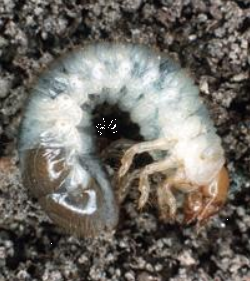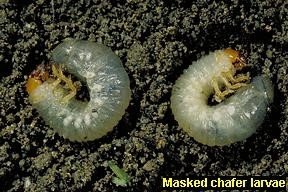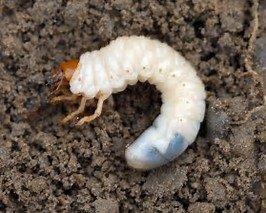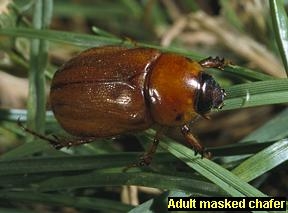Advice for the Home Gardener from the
Help Desk of the UC Master Gardener Program
of Contra Costa County
Home Gardener's Request: Thank you for calling the UC Master Gardener Program Help Desk concerning moles in your lawn. I'm sending links (below) for the information that we promised.
Master Gardener Help Desk Response:
For Moles: http://ipm.ucanr.edu/PMG/PESTNOTES/pn74115.html.
You mentioned that you have had grubs previously, and it may be that moles are still present because grubs are a food source for them. If you can eliminate the grubs, the moles may move on. The above 'pest note' link (above) suggests that trapping is the most dependable control method for moles, and it gives detailed information should you decide this is necessary.
For Grubs: The links following also provide some information on lawn grubs: http://ipm.ucanr.edu/TOOLS/TURF/PESTS/inchaf.html
This link gives more details about treatment: http://ipm.ucanr.edu/PMG/PESTNOTES/pn7476.html
Turf Management: Finally, UC has an extensive website on general lawn management at:
http://ipm.ucanr.edu/TOOLS/TURF/
Most control methods for grubs are only effective while they are actively feeding and as we move into the colder part of the year, grubs are not so active. You can check your lawn by rolling back a bit of turf to see if grubs are present. If the mole damage is not too great, you might want to wait until spring to reassess the situation. Meanwhile, plan on giving your lawn the best care, with adequate irrigation and care and not to over-fertilize. This will give it the lawn its best chance to withstand pest damage.
If you have further questions, please do not hesitate to contact the Help Desk again.
Good luck with your lawn!
Help Desk of the UC Master Gardener Program of Contra Costa County (SMW)
Notes: Contra Costa MG's Help Desk is available almost year-round to answer your gardening questions. Except for a few holidays (e.g., last 2 weeks December), we're open every week, Monday through Thursday for walk-ins from 9:00 am to Noon at 2380 Bisso Lane, Concord, CA 94520. We can also be reached via telephone: (925) 608-6683, email: ccmg@ucanr.edu, or on the web at http://ccmg.ucanr.edu/Ask_Us/. MGCC Blogs can be found at http://ccmg.edu/HortCoCo/ You can also subscribe to the Biog.
Advice for the Home Gardener from the Help Desk of the
UC Master Gardener Program of Contra Costa County
MGCC's Help Desk Response: Thank you for contacting the UC Master Gardener Program's Help Desk about the grubs in your planters. Grubs are primarily pests of lawn grass, preferring turf grass roots to other plants. While they will feed on other plants' roots, they typically are not a big problem in planters.
It's not unusual to find grubs in your soil in the winter. The larvae overwinter in the soil, and emerge in late spring and summer. Your picking them out of the soil and leaving them on top for the birds was exactly the right thing to do. You don't need to discard the soil. Most gardens can tolerate some grubs in the soil, unless the population becomes very high.
For more information about grubs in a vegetable garden MGCC Help Desk covered previously, follow this link: https://ucanr.edu/blogs/blogcore/postdetail.cfm?postnum=25191. Included in that link is another link to using beneficial nematodes to control grubs if you find you continue to have problems.
Happy gardening! Please contact us again if you have more questions.
Help Desk of the UC Master Gardener Program of Contra Costa County (SEH)
Note: UC Master Gardeners Program of Contra Costa's Help Desk is available almost year-round to answer your gardening questions. Except for a few holidays (e.g., last 2 weeks December), we're open every week, Monday through Thursday for walk-ins from 9:00 am to Noon at 2380 Bisso Lane, Concord, CA 94520. We can also be reached via telephone: (925) 608-6683, email: ccmg@ucanr.edu, or on the web at http://ccmg.ucanr.edu/Ask_Us/. MGCC Blogs can be found at http://ccmg.ucanr.edu/HortCoCo/ You can also subscribe to the Blog.
Advice for the Home Gardener From the Help Desk of the
UC Master Gardener Program of Contra Costa County
Client's Request: I need some help in ridding my raised vegetable beds of white grubs. This is a school garden and I haven't had this problem before. I have been researching the various types of control from Diatomaceous Earth to White Milky Spore, etc., and I haven't come up with a solution but having the children of our school dig for them. I would like to eradicate them as soon as possible as I need to get my vegetable transplants into the raised beds. I look forward to getting your advice.
MGCC Help Desk Response: Thank you for contacting the UC Master Gardener Program Help Desk with your questions about removing white grubs from your school's raised vegetable beds.
The grubs you are seeing are most likely the larval stage of masked chafer beetles. The ¾ inch adult beetles are golden brown in color, with dark brown heads and hairy undersides. The grubs are whitish in color, with brown heads and legs, dark stripes on their backs, and bristles on the undersides of their posterior abdomens. The fully grown grubs are about an inch in length, and are c-shaped.
Here is a picture of these masked chafer grubs:

The grubs are root feeders, and are typically found in lawns, although they are found in vegetable beds as well.
This UC publication provides some information on masked chafer grubs: http://ipm.ucanr.edu/TOOLS/TURF/PESTS/inchaf.html
Physical removal of the grubs from the beds is the first line of defense. Your students' hand-picking is a great approach. You can also get help from birds and other predators by turning over the soil to expose the grubs.
Beneficial nematodes can also be used for biological control of grubs, as described in the article at the following link: http://ipm.ucanr.edu/TOOLS/TURF/PESTS/innem.html.
The challenge, though, is that the timing for beneficial nematodes is not optimum. Beneficial nematodes are most effective against white grubs in the summer and early fall and requires soil temperatures above 60 degrees. This may be something to consider as you wrap up your vegetable garden in the late summer.
In terms of the products that you were considering, there are no indications from the University of California that the products are effective. Milky White Spore is most effective against Japanese Beetle larvae, which are essentially not present in California. The beneficial nematodes are the recommended alternative.
There is also no UC information indicating that diatomaceous earth is effective. One concern about diatomaceous earth is that it could kill ls beneficial insects, so you may not want to put it in your vegetable bed.
There are some chemicals, such as imidacloprid, that can be used, but this is primarily in lawns, and timing has to be exact. I would not want to recommend it for a vegetable garden.
Hand-picking is the best approach. While the grubs can damage vegetables, if your students can keep the grub population under control through hand-picking, your vegetables may do fine.
One additional note of caution: Be careful when it comes to amending the soil in your beds with fresh compost (e.g., made on-site). That compost could contain masked chafer eggs. The larvae (grubs) will locate and feed on roots after they hatch. Before applying compost, be sure it has been properly prepared with sufficient heat to decompose the organic material and to kill insect eggs and other organisms.
Good luck with your vegetable garden. Let us know if you have further questions.
Help Desk of the UC Master Gardener Program of Contra Costa County (ECS)
|
|
Help for the Home Gardener from the Help Desk of the
UC Master Gardener Program of Contra Costa County
MGCC Help Desk Response: Thank you for contacting the UC Master Gardener Program Help Desk with your questions about grubs in your vegetable bed. I enjoyed talking to you today, and the picture you sent was helpful as well.
Following is some information on masked chafer grubs. http://ipm.ucanr.edu/TOOLS/TURF/PESTS/inchaf.html
Possible treatment options include hand-picking to remove any grubs you find in the soil, or turning the soil to expose grubs to birds and other predators. Beneficial nematodes can also be used for biological control of grubs, as described in the article at the following link. http://ipm.ucanr.edu/TOOLS/TURF/PESTS/innem.html
If you do remove the soil to start again (as you mentioned you might), be careful with any compost you add. The adult beetles can be attracted to fresh compost or organic matter, where they will lay their eggs. The larvae (grubs) will locate and feed on roots after they hatch. Before applying compost, be sure it had been properly prepared with sufficient heat to decompose the organic material and to kill insect eggs and other organisms. Information on rapid composting can be found at this UC link: http://anrcatalog.ucanr.edu/pdf/8037.pdf
I hope you are able to get rid of your grubs before next season. Do let us know if you have further questions.
Help Desk of the UC Master Gardener Program of Contra Costa County (TKT)
Note: The UC Master Gardeners Program of Contra Costa's Help Desk is available year-round to answer your gardening questions. Except for a few holidays, we're open every week, Monday through Thursday for walk-ins from 9:00 am to Noon at 75 Santa Barbara Road, 2d Floor, Pleasant Hill, CA 94523. We can also be reached via telephone: (925)646-6586, email: ccmg@ucanr.edu, or on the web at http://ccmg.ucanr.edu/Ask_Us/ MGCC Blogs can be found at http://ccmg.ucanr.edu/HortCoCo/ You can also subscribe to the Blog (http://ucanr.edu/blogs/CCMGBlog/).


